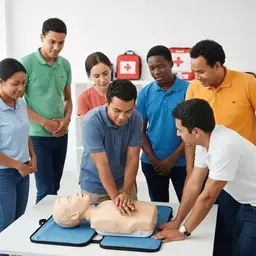Entry Medicals
Conducted before employment to assess an individual's fitness for their designated role.
Join the OHS Hub South Africa community for essential safety insights, compliance tips, and product updates.
Posted on: 2025-11-14
By: Thandiwe Mokoena
What if the key to a safer workplace lay in understanding the medical assessments required for compliance? In South Africa, these evaluations are more than just formalities; they are vital to fostering a culture of safety and well-being in various work environments.
This visual highlights the distinctions between Entry, Periodic, and Exit Medicals, essential for ensuring a safe and compliant work environment under South African regulations.
Conducted before employment to assess an individual's fitness for their designated role.
Performed at regular intervals to monitor ongoing health and fitness of employees.
Carried out when an employee leaves to document any work-related health issues.
Reduces legal penalties, mitigates risks, and fosters a strong safety culture.
When we talk about workplace safety, one crucial aspect often overlooked is the importance of medicals for compliance. In South Africa, these medical assessments are not just a box-checking exercise; they are vital for ensuring a safe and healthy work environment. By understanding the different types of medicals and their significance, employers and employees alike can foster a culture of safety that benefits everyone!
At OHS Hub South Africa, we believe that promoting awareness about these medical evaluations is key. After all, every workplace has unique health risks that must be managed effectively. Let’s dive into the details of entry, periodic, and exit medicals to see how they play a role in compliance.
Let’s start by defining what we mean by entry, periodic, and exit medicals. Here’s a quick breakdown:
Understanding these categories is essential for both employers and employees. Each type of medical serves a purpose, providing insights into health trends and compliance with occupational health standards.
Compliance with medical requirements isn't just about adhering to the law; it's about creating a safe workplace for everyone involved. For employers, this means avoiding legal issues, reducing liability, and enhancing overall productivity. For employees, it translates to a commitment to their health and well-being on the job.
Here’s why compliance is crucial:
In short, compliance benefits everyone. By prioritizing medical evaluations, we can ensure that workplaces remain safe and conducive to healthy productivity!
Medical surveillance plays a pivotal role in workplace health management. It involves ongoing monitoring of employees’ health to detect potential job-related illnesses early on. At OHS Hub South Africa, we emphasize the importance of implementing a solid medical surveillance system that aligns with South African regulations.
This proactive approach to health management can help identify hazards and provide timely interventions. Here's what effective medical surveillance encompasses:
By integrating medical surveillance into your health strategy, you create a safer work environment where employees feel valued and cared for. Remember, a healthy workforce is a productive workforce!
To ensure compliance and enhance workplace safety, consider implementing a digital tracking system for medical assessments. This not only streamlines the process but also provides a comprehensive overview of employee health data, making it easier to identify trends and areas for improvement. Regularly review these assessments to stay ahead of potential health issues and foster a culture of proactive safety.
The three main types are Entry Medicals (before employment), Periodic Medicals (at regular intervals during employment), and Exit Medicals (when an employee leaves the company).
Compliance helps employers avoid legal penalties and fines, reduces the risk of workplace injuries and illnesses, mitigates liability, and fosters a strong safety culture, ultimately enhancing productivity.
Medical surveillance involves ongoing monitoring of employees' health to detect potential job-related illnesses early, identify hazards, and provide timely interventions, aligning with South African regulations.
The primary regulations are the Mine Health and Safety Act (MHSA) and the Occupational Health and Safety Act (OHS Act), which set legal requirements for health assessments in various work environments.
Section 17 of the MHSA specifically mandates medical evaluations for mine workers before employment, periodically during employment, and upon termination, to ensure fitness for duty and prevent occupational diseases.
Understanding the legal framework governing medicals in South Africa is crucial for employers and employees alike. The compliance landscape is shaped by several key regulations, notably the Mine Health and Safety Act (MHSA) and the Occupational Health and Safety Act (OHS Act). These regulations establish the legal requirements for health assessments in various work environments, ensuring a commitment to safety and worker protection.
Employers need to be aware of how these regulations affect their operations. Adhering to these standards is not just about avoiding legal repercussions; it's about fostering a culture of safety and well-being within the workplace. At OHS Hub South Africa, we help businesses navigate these complex regulations, ensuring compliance while promoting a safe working environment.
The MHSA and the OHS Act set forth specific guidelines regarding medicals that are essential for ensuring workplace safety. Here are some of the key regulations to consider:
Awareness of these regulations empowers businesses to implement effective health and safety measures, minimizing risks for employees and enhancing overall workplace safety.
Section 17 of the MHSA specifically addresses the requirements for medical assessments in mining. It outlines the necessity for employers to conduct medical evaluations before employment, periodically during employment, and upon termination. This is critical to ensure that workers are fit for duty and not at risk of occupational diseases.
As a professional in the occupational health field, I often encounter questions about how to implement these assessments effectively. Here are some key elements to consider:
By adhering to these guidelines, businesses not only comply with the law but also prioritize the health and safety of their workforce.
The South African Department of Employment and Labour plays a significant role in enforcing compliance with the OHS Act and MHSA. This department is responsible for monitoring workplace conditions and ensuring that employers meet their health and safety obligations.
Employers should be proactive in engaging with this department by:
By maintaining an open line of communication with this department, employers can ensure they are always compliant and contributing to a safer workplace.
Here is a quick recap of the important points discussed in the article:



 How often do you consider the vital role that PPE gloves play in workplace safety? In industries ran
How often do you consider the vital role that PPE gloves play in workplace safety? In industries ran
 Are you aware that first aid training can be the difference between life and death in emergencies? U
Are you aware that first aid training can be the difference between life and death in emergencies? U
 As workplace safety becomes increasingly critical, understanding the role of drug screening can lead
As workplace safety becomes increasingly critical, understanding the role of drug screening can lead